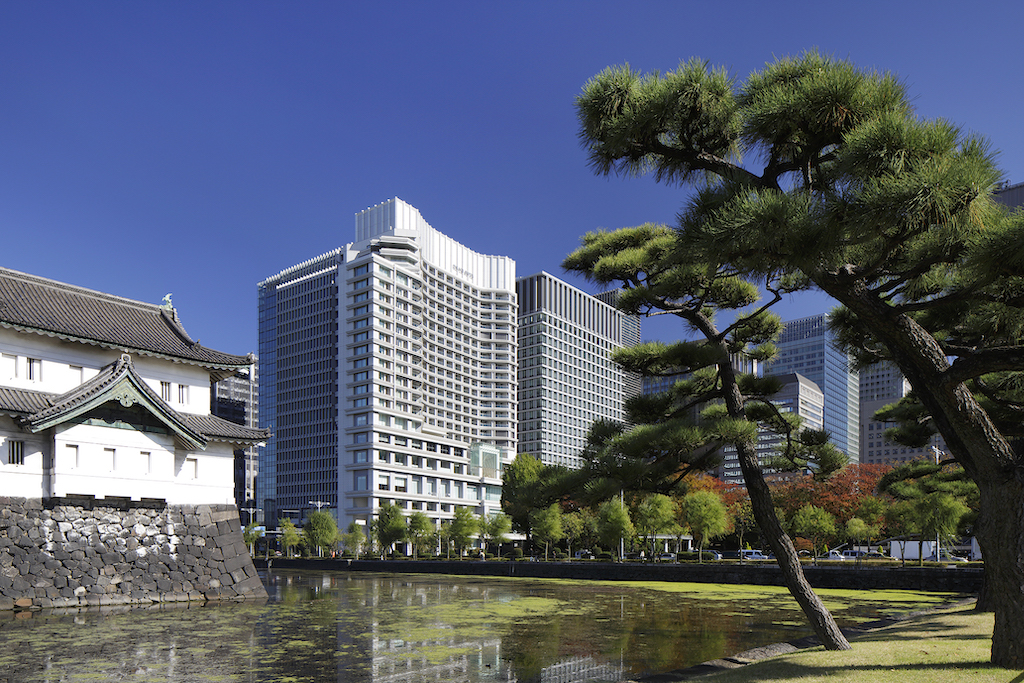
Located in the capital’s prestigious Marunouchi district, Palace Hotel Tokyo faces unmatched views of the city’s skyline and the Imperial Palace gardens (it even shares a moat with these beautifully manicured gardens).
The hotel, which is the anchor to a billion dollar mixed-use development, commands some of the city’s most exclusive real estate. Drawing from the country’s history, culture and art, the iconic establishment continues to redefine luxury in Japan with sophistication and authenticity.
This Japanese-owned and managed hotel, which underwent a complete rebuild in 2012, boasts more than 1,000 permanent pieces of art that can be found throughout the different areas. The most notable pieces are seen in the hotel’s public spaces, including the main lobby and reception area.
 Palace Hotel Tokyo overlooks the Imperial Palace gardens
Palace Hotel Tokyo overlooks the Imperial Palace gardens
Nature plays a central role as the inspiration behind many of the artworks. This is in line with overarching concept of the hotel’s beautiful natural surroundings and the uniqueness of the Japan’s heritage.
Aside from the public spaces, the hotel’s newly refurbished suites also feature contemporary Japanese ink wash paintings, sculptural porcelain and ceramic pieces. They are all original and exclusive to Palace Hotel Tokyo, most having been commissioned specifically for the new suites.
Curated by Art Front Gallery, the eclectic array of pieces showcases the talents of up-and-coming creators as well as that of more prominent artists. Many of the paintings, watercolours, sculptures and other works were commissioned specifically for the hotel.
The following are some highlights adorning the public spaces:
 Echoes – Crystallization
Echoes – Crystallization
Acting as a backdrop to the main reception desk is the massive wall installation - ‘Echoes-Crystallization’ by Shinji Ohmaki. What’s interesting about this pure white backdrop is that correction fluid and crystal power were crystallised to create a depiction of endangered species of Japanese flowers. The artist who uses simple materials to produce installations that boldly transform a space says, “These vanishing blooms embody my wish for viewers to re-visit and re-examine the trifling aspects of their daily lives. Representing the desire to create a new world, this piece is a reminder of the sights and sounds that are disappearing from our lives as society develops."


Landscapes of The Palace by Takeharu Nakabayashi is a stunning installation crafted from gold leaf, iron and paint. From a distance, it looks like a large floor-to-ceiling screen. This work is a combination of the various landscapes found in the vicinity of Palace Hotel Tokyo. "Both sides of the work are pieces of art in their own right,” says the artist who uses metal materials for his work. At the main lobby entrance is contemporary artist Masahito Katayama’s ‘Sunflower’ painting. Bright yellow pigment and transparent layers were used to evoke light and pollen.
 Early morning
Early morning
In the main lobby lounge, guests can admire “Early Morning” by Mika Toba who created this artwork using the indigenous dyeing method – katazome – over Hakusan silk pongee. This traditional woven fabric has been made in the Shiramine District at the foot of Mt. Hakusan for over 800 years. Katazome stencil dyeing is a Japanese method of dyeing fabrics using a resist paste applied through a stencil. This painting changes its colours and expressions with the changes of the seasons and with the change of lighting throughout the day.
 Shikisai no Shita
Shikisai no Shita
Satoshi Uchiumi’s vibrant floral oil painting ‘Shikisai no Shita’ (Under the Colours) is seen at the hotel’s foyer on the second level. The artist, who’s well-known in the contemporary world of abstract painting, typically combines dots of colour in his compositions as seen in this interpretation of vibrant blue flowers. He says, “According to The Book of Tea by Kakuzo Okakura, since ancient times, Japanese architecture has used seasonal flowers, hanging scrolls and other such devices to create spaces that are clear and colourless, neither too much nor too little.” His desire is for paintings to be “one of these numerous conscious manipulations required for the creation of serene everyday spaces”.
The extensive collection is detailed on a dedicated website and in The Art of Palace Hotel Tokyo book.


 Share
Share








